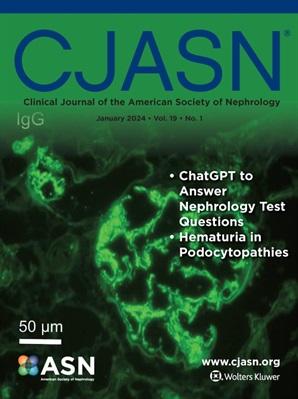Randomized Controlled Trial of Walking Training with and Without Blood Flow Restriction in Patients Treated with Maintenance Hemodialysis
IF 8.5
1区 医学
Q1 UROLOGY & NEPHROLOGY
Clinical Journal of the American Society of Nephrology
Pub Date : 2025-04-04
DOI:10.2215/cjn.0000000701
引用次数: 0
Abstract
nd walking training (WT) versus usual care controls on walking capacity among hemodialysis patients. Methods Patients treated with maintenance hemodialysis were recruited from two dialysis units in Suzhou, China between February to June 2024, and were randomly allocated into three groups using block randomization. The control group received usual care. The WT group received eight weeks of low-to-moderate intensity walking intervention. The WT-BFR group received the same intervention as the WT group, with the addition of 40% to 50% limb occlusion pressure applied during walking sessions. Walking capacity (primary outcome), physical function, health-related quality of life, anxiety, and depression were assessed at baseline, eight weeks, and 16 weeks. Results Fifty-seven eligible patients with a mean age of 54 years (Standard Deviation=10) were recruited. They were randomly allocated equally into the control group (N=19), WT-BFR group (N=19), and WT group (N=19). From baseline to eight weeks, the improvements in walking capacity were greater in the WT-BFR (mean differences and 95% confidence interval: 48.48, 28.81 to 68.16 meters) and WT (31.70, 9.29 to 54.11 meters) groups compared to the control group. At 16 weeks, the WT-BFR group also demonstrated a greater improvement in walking capacity than the WT group (34.63, 8.90 to 60.36 meters). Similarly, the WT-BFR and WT groups showed greater improvements in physical function and disease-specific domains of health-related quality of life, compared to the control group. Conclusions After an eight-week intervention, both WT-BFR and WT improved walking capacity, physical function, and health-related quality of life in maintenance hemodialysis patients. However, the prolonged benefits of WT-BFR in the hemodialysis population require further investigation. Copyright © 2025 by the American Society of Nephrology...维持性血液透析患者有和没有血流限制的步行训练的随机对照试验
步行训练(WT)与常规护理对照对血液透析患者步行能力的影响。方法 2024 年 2 月至 6 月期间,从中国苏州的两家透析单位招募了接受维持性血液透析治疗的患者,采用整群随机法将其随机分配到三组。对照组接受常规治疗。WT 组接受为期八周的中低强度步行干预。WT-BFR组接受与WT组相同的干预,但在步行过程中增加了40%至50%的肢体闭塞压力。分别在基线、8 周和 16 周对步行能力(主要结果)、身体功能、与健康相关的生活质量、焦虑和抑郁进行评估。结果 共招募了 57 名符合条件的患者,他们的平均年龄为 54 岁(标准差=10)。他们被随机平均分配到对照组(19 人)、WT-BFR 组(19 人)和 WT 组(19 人)。从基线到八周,与对照组相比,WT-BFR 组(平均差和 95% 置信区间:48.48 米,28.81 米至 68.16 米)和 WT 组(31.70 米,9.29 米至 54.11 米)的步行能力提高幅度更大。在 16 周时,WT-BFR 组的行走能力也比 WT 组(34.63 米,8.90 米至 60.36 米)有更大的提高。同样,与对照组相比,WT-BFR 组和 WT 组在身体功能和与疾病相关的健康生活质量方面也有较大改善。结论 经过八周的干预后,WT-BFR 和 WT 均改善了维持性血液透析患者的行走能力、身体功能和与健康相关的生活质量。然而,WT-BFR 对血液透析人群的长期益处还需要进一步研究。版权所有 © 2025 年美国肾脏病学会...
本文章由计算机程序翻译,如有差异,请以英文原文为准。
求助全文
约1分钟内获得全文
求助全文
来源期刊
CiteScore
12.20
自引率
3.10%
发文量
514
审稿时长
3-6 weeks
期刊介绍:
The Clinical Journal of the American Society of Nephrology strives to establish itself as the foremost authority in communicating and influencing advances in clinical nephrology by (1) swiftly and effectively disseminating pivotal developments in clinical and translational research in nephrology, encompassing innovations in research methods and care delivery; (2) providing context for these advances in relation to future research directions and patient care; and (3) becoming a key voice on issues with potential implications for the clinical practice of nephrology, particularly within the United States. Original manuscript topics cover a range of areas, including Acid/Base and Electrolyte Disorders, Acute Kidney Injury and ICU Nephrology, Chronic Kidney Disease, Clinical Nephrology, Cystic Kidney Disease, Diabetes and the Kidney, Genetics, Geriatric and Palliative Nephrology, Glomerular and Tubulointerstitial Diseases, Hypertension, Maintenance Dialysis, Mineral Metabolism, Nephrolithiasis, and Transplantation.

 求助内容:
求助内容: 应助结果提醒方式:
应助结果提醒方式:


